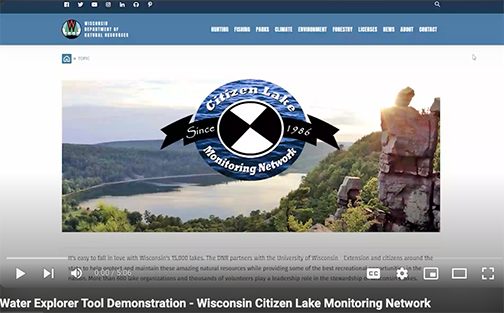Citizen Lake Monitoring Network


 Check out this NEW VIDEO showing how to use the Wisconsin DNR's new Water Explorer (WEx) tool to see Citizen Lake Monitoring Network data and compare a selected year to previous years of data to better understand trends in water quality. The WEx tool generates a variety of graphs and visualizations to show the data and identify trends.
Check out this NEW VIDEO showing how to use the Wisconsin DNR's new Water Explorer (WEx) tool to see Citizen Lake Monitoring Network data and compare a selected year to previous years of data to better understand trends in water quality. The WEx tool generates a variety of graphs and visualizations to show the data and identify trends.
The Citizen Lake Monitoring Network (CLMN) creates a bond between 1000+ citizen volunteers statewide and the Wisconsin Lakes Partnership. Our goals are to collect high-quality lake monitoring data, educate and empower our volunteers, and share our data to inform lake management.
CLMN staff provide volunteers with the necessary equipment and training to conduct these monitoring activities. Volunteers provide their time, expertise, energy, and a willingness to share information with their fellow lake residents or other lake users. The information gathered by these monitoring programs is used by Wisconsin Department of Natural Resources and university biologists and researchers, UW-Madison Division of Extension, and other interested individuals.
What do CLMN volunteers monitor?
The volunteer lowers an 8” diameter, black & white disc (“Secchi disc”) into the deepest part of the lake to determine how far down they can see the disc as it is lowered. Water clarity monitoring is done every 10-14 days throughout the open-water season. Water clarity is a quick way to estimate lake health, and it plays an important role in determining the types of plants and animals that a water body can support.
read more...
Water chemistry volunteers measure phosphorus levels, chlorophyll-A concentrations (a measure of algae growth in the water), water clarity, and a temperature profile from the top to the bottom of the lake. This type of monitoring is done four times per year, and requires several hours of time during each monitoring event. Chemistry monitoring helps determine if nutrient pollution is occurring in a lake, or if seasonal fish die-offs may be a possibility due to low oxygen levels.
read more...
This is a simple type of lake monitoring. Volunteers simply record the date that ice completely covers the lake in the fall, and record the date that the ice is completely gone from the lake in the spring. This information is used to track changes in the open-water season, which is useful in many different types of lake-related research projects.
read more...
AIS monitoring involves searching the lake for aquatic invasive species like Eurasian watermilfoil, zebra mussels, rusty crayfish, and others. The frequency that volunteers perform AIS monitoring varies, but most volunteers do this a few times per year. Most volunteers conduct AIS monitoring in high-risk sites around their lakes (like boat landings) to detect early populations of AIS. Early detection of AIS is crucial for effective, inexpensive management, so these volunteers are incredibly valuable
.
read more...
This type of volunteer lake monitoring involves collecting data on a lake’s native aquatic plant community. These activities are repeated every 2-3 years to track changes in the abundance and distribution of these species. Aquatic plant identification training is provided by the CLMN Educator or the Regional CLMN Coordinator, usually at the lake being monitored. Native plant monitoring is broken down into three levels, which a volunteer can choose from depending on their familiarity with aquatic plant identification and the amount of time they have available.
read more... Level IVolunteers collect and preserve a sample of each aquatic plant species in their lake and send them to the CLMN Educator for identification. The samples will be identified and returned to the volunteer as a reference collection.
Level IIVolunteers note general categories of plants (submergent, emergent, and floating-leaf plants) around their lake on a map. They also collect a sample of each aquatic plant species to send to the CLMN Educator for identification, and these samples are returned.
Level IIIVolunteers learn to identify the aquatic plants of their lake, and create a map of the general species distribution around the lake. Again, volunteers collect samples of each aquatic plant species for ID verification by the CLMN Educator, which are returned to the volunteer.
These coordinators are your primary contact for equipment, reports and additional training opportunities.
These staff are great local contacts for AIS issues.
For more information, contact
Paul Skawinski, Statewide Citizen Lake Monitoring Network Educator
Or go to:
